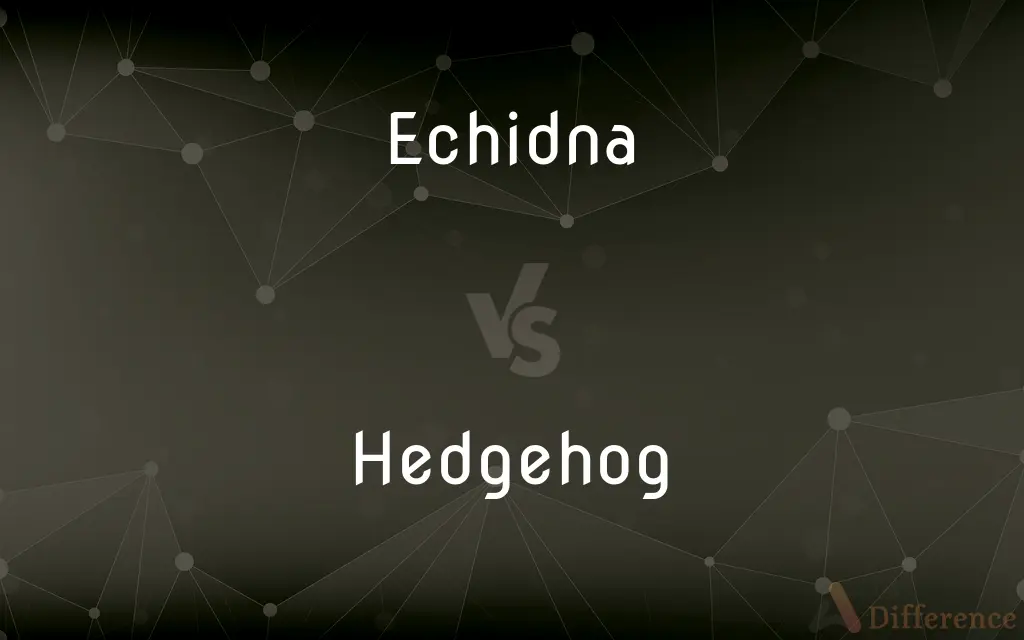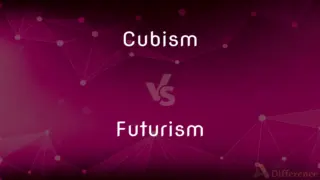Echidna vs. Hedgehog — What's the Difference?
By Tayyaba Rehman & Fiza Rafique — Updated on September 12, 2023
An echidna is an egg-laying mammal native to Australia and New Guinea, with spines and a long snout for eating ants. A hedgehog is a spine-covered mammal found in Europe, Asia, and Africa, which gives live birth and primarily eats insects.

Difference Between Echidna and Hedgehog
Table of Contents
ADVERTISEMENT
Key Differences
An echidna is a monotreme, which means it is one of the few mammals that lay eggs. Native to Australia and New Guinea, echidnas have coarse hair and spines and are equipped with a long, slender snout that is both a mouth and a nose. Hedgehogs, on the other hand, are found in Europe, Asia, and Africa, and belong to the eutherian mammals, meaning they give live birth.
Echidnas primarily feed on ants and termites, using their snouts to dig into anthills and their sticky tongues to capture their prey. Hedgehogs are more generalist insectivores. They eat a range of foods, including insects, fruits, and vegetation, and have short, rounded snouts suited to this varied diet.
An echidna has spines like a hedgehog, but its spines are mingled with fur. The echidna's spines are not as easily detachable as those of the hedgehog. Hedgehogs are famous for their ability to roll into a ball when threatened, their spines providing effective protection against predators.
Echidnas have a lower body temperature compared to other mammals, including hedgehogs. Echidnas also have an elongated, specialized reproductive organ, quite different from that of hedgehogs. Hedgehogs have a more traditional mammalian reproductive system and are also more readily found in domestic settings as pets.
Comparison Chart
Geographic Range
Australia, New Guinea
Europe, Asia, Africa
ADVERTISEMENT
Feeding Habits
Ants and termites
Insects, fruits, and vegetation
Reproduction
Egg-laying (monotreme)
Live birth (eutherian)
Defensive Action
Spines mixed with fur, less detachable
Spines easily detachable, rolls into a ball
Body Temperature
Lower than most mammals
Typical mammalian body temperature
Compare with Definitions
Echidna
A spiny, egg-laying mammal native to Australia and New Guinea.
The echidna uses its long snout to eat ants.
Hedgehog
A small, spiny mammal primarily found in Europe, Asia, and Africa.
The hedgehog curled into a ball when threatened.
Echidna
A creature with a long, slender snout serving as both nose and mouth.
The echidna's snout is uniquely adapted to its diet.
Hedgehog
A mammal sometimes kept as a pet.
Hedgehogs are more commonly found as pets than echidnas.
Echidna
A monotreme with coarse hair and spines.
Unlike most mammals, the echidna lays eggs.
Hedgehog
A generalist insectivore with a varied diet.
Hedgehogs eat both insects and fruits.
Echidna
A mammal with a lower body temperature compared to other mammals.
The echidna's lower body temperature helps it survive in various environments.
Hedgehog
A eutherian mammal that gives live birth.
Unlike the echidna, hedgehogs give live birth.
Echidna
An animal specialized in ant and termite consumption.
Echidnas have a unique way of breaking into anthills.
Hedgehog
An animal with detachable spines for defense.
The hedgehog's spines easily detach to deter predators.
Echidna
Echidnas (), sometimes known as spiny anteaters, belong to the family Tachyglossidae in the monotreme order of egg-laying mammals. The four extant species of echidnas and the platypus are the only living mammals that lay eggs and the only surviving members of the order Monotremata.
Hedgehog
A hedgehog is a spiny mammal of the subfamily Erinaceinae, in the eulipotyphlan family Erinaceidae. There are seventeen species of hedgehog in five genera found throughout parts of Europe, Asia, and Africa, and in New Zealand by introduction.
Echidna
A spiny insectivorous egg-laying mammal with a long snout and claws, native to Australia and New Guinea.
Hedgehog
Any of several small insectivorous mammals of the subfamily Erinaceinae, native to Eurasia and Africa and naturalized in New Zealand, having dense erectile spines covering the back and sides and characteristically rolling into a ball for protection.
Echidna
Any of several nocturnal burrowing egg-laying mammals of the genera Tachyglossus and Zaglossus of Australia, Tasmania, and New Guinea, having a spiny coat, a slender snout, and an extensible sticky tongue used for catching insects.Also called spiny anteater.
Hedgehog
Any of several spiny animals, such as the porcupine, that are similar to the hedgehog.
Echidna
Any of the species of small spined monotremes in family Tachyglossidae, the four extant species of which are found in Australia and southern New Guinea.
Hedgehog
A well fortified military position.
Echidna
A monster, half maid and half serpent.
Hedgehog
An antisubmarine weapon consisting of several rows of mortar-like dischargers positioned to fire in a circular pattern ahead of a ship.
Echidna
A genus of Monotremata found in Australia, Tasmania, and New Guinea. They are toothless and covered with spines; - called also porcupine ant-eater, and Australian ant-eater.
Hedgehog
An obstacle used against tanks and landing craft, consisting of three crossed iron bars welded or bolted together.
Echidna
New Guinea echidnas
Hedgehog
A small mammal, of the family Erinaceidae or subfamily Erinaceinae (pl=s, the latter characterized by their spiny back and often by the habit of rolling up into a ball when attacked.)
Echidna
Burrowing spine-covered monotreme of Australia having a long snout and claws for hunting ants and termites
Hedgehog
(US) Any of several spiny mammals, such as the porcupine, that are similar to the hedgehog.
Hedgehog
(military) Czech hedgehog an antitank obstacle constructed from three steel rails.
Hedgehog
A spigot mortar-type of depth charge weapon from World War II that simultaneously fires a number of explosives into the water to create a pattern of underwater explosions intended to attack submerged submarines. Category:en:World War II
Hedgehog
(Australia) A type of chocolate cake (or slice), somewhat similar to an American brownie.
Hedgehog
A form of dredging machine.
Hedgehog
Certain flowering plants with parts resembling a member of family Erinaceidae
Hedgehog
Medicago intertexta, the pods of which are armed with short spines.
Hedgehog
Retzia capensis of South Africa.
Hedgehog
The edible fungus Hydnum repandum.
Hedgehog
A kind of electrical transformer with open magnetic circuit, the ends of the iron wire core being turned outward and presenting a bristling appearance.
Hedgehog
A way of serving food at a party, consisting of a half melon or potato etc. with individual cocktail sticks of cheese and pineapple stuck into it.
Hedgehog
(differential geometry) A type of plane curve; see Hedgehog (geometry). Category:en:Curves
Hedgehog
(military) To make use of a hedgehog barricade as a defensive maneuver.
Hedgehog
To array with spiky projections like the quills of a hedgehog.
Hedgehog
(ambitransitive) To curl up into a defensive ball.
Hedgehog
A small European insectivore (Erinaceus Europæus), and other allied species of Asia and Africa, having the hair on the upper part of its body mixed with prickles or spines. It is able to roll itself into a ball so as to present the spines outwardly in every direction. It is nocturnal in its habits, feeding chiefly upon insects.
Hedgehog
The Canadian porcupine.
Hedgehog
A species of Medicago (Medicago intertexta), the pods of which are armed with short spines; - popularly so called.
Hedgehog
A form of dredging machine.
Hedgehog
A variety of transformer with open magnetic circuit, the ends of the iron wire core being turned outward and presenting a bristling appearance, whence the name.
Hedgehog
A defensive obstacle having pointed barbs extending outward, such as one composed of crossed logs with barbed wire wound around them, or a tangle of steel beams embedded in concrete used to impede or damage landing craft on a beach; also, a position well-fortified with such defensive obstacles.
Hedgehog
Relatively large rodents with sharp erectile bristles mingled with the fur
Hedgehog
Small nocturnal Old World mammal covered with both hair and protective spines
Common Curiosities
How does an Echidna reproduce?
Echidnas are monotremes, meaning they lay eggs.
Where is the Echidna found?
The echidna is native to Australia and New Guinea.
Where is the Hedgehog found?
Hedgehogs are found in Europe, Asia, and Africa.
What is unique about the Echidna's body temperature?
The echidna has a lower body temperature compared to most mammals.
What does an Echidna eat?
Echidnas primarily eat ants and termites.
What does a Hedgehog eat?
Hedgehogs eat insects, fruits, and vegetation.
Can Hedgehogs roll into a ball?
Yes, hedgehogs can roll into a ball for defense.
Are Echidnas found as pets?
No, echidnas are not commonly kept as pets.
Are Hedgehogs found as pets?
Yes, hedgehogs are sometimes kept as pets.
How does a Hedgehog reproduce?
Hedgehogs are eutherian mammals that give live birth.
Is the Echidna's snout different from the Hedgehog's?
Yes, the echidna has a long, slender snout while the hedgehog has a short, rounded snout.
Do Echidnas have detachable spines?
No, echidna spines are less detachable compared to hedgehogs.
Is it easier to observe a Hedgehog in the wild?
Hedgehogs are generally easier to observe due to their broader geographic range.
Do Hedgehogs have detachable spines?
Yes, their spines are easily detachable.
Can Echidnas swim?
Yes, echidnas are capable swimmers, unlike hedgehogs.
Share Your Discovery

Previous Comparison
Portend vs. Portent
Next Comparison
Cubism vs. FuturismAuthor Spotlight
Written by
Tayyaba RehmanTayyaba Rehman is a distinguished writer, currently serving as a primary contributor to askdifference.com. As a researcher in semantics and etymology, Tayyaba's passion for the complexity of languages and their distinctions has found a perfect home on the platform. Tayyaba delves into the intricacies of language, distinguishing between commonly confused words and phrases, thereby providing clarity for readers worldwide.
Co-written by
Fiza RafiqueFiza Rafique is a skilled content writer at AskDifference.com, where she meticulously refines and enhances written pieces. Drawing from her vast editorial expertise, Fiza ensures clarity, accuracy, and precision in every article. Passionate about language, she continually seeks to elevate the quality of content for readers worldwide.
















































